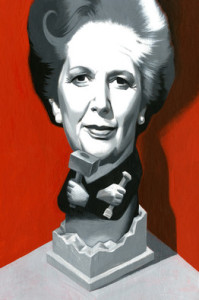The Wall Street Journal: The Special Vilification of Female Leaders
Thirty-five years ago this Sunday, Margaret Thatcher became the first woman to be elected British prime minister. She wasn’t the first woman to be at the head of what had often been “Her Majesty’s Government,” of course, but only Thatcher had fought her way to parliamentary power via a general election. Standing on the steps of 10 Downing Street, she acknowledged the sexual and political revolution that had taken place. To her naysayers, Thatcher offered the famous prayer of St. Francis of Assisi: “Where there is discord, may we bring harmony…where there is doubt, may we bring faith.”
During her 11 years in office, Thatcher repaid her Tory supporters’ faith, eradicating any last doubts that a woman could govern as well as a man. But her wish to bring harmony was in vain. Judging by the names she was called, Thatcher attracted a unique hatred among some Britons that was hard to separate from the fact she was a woman. After Thatcher’s death in 2013, a vociferous minority campaigned to propel the song “Ding Dong! The Witch Is Dead” to the top of the official U.K. singles chart. It stopped at No. 2.
The special vilification reserved for female leaders has a long history. The earliest cast-iron record of a woman who ruled in her own right is that of Queen Hatshepsut of Egypt (about 1508-1458 B.C.). Although Hatshepsut began her reign as the regent for her young stepson and nephew, Thutmose III, she went further and claimed the throne for herself as pharaoh. Since ancient Egypt had no word or imagery for a female pharaoh, Hatshepsut often depicted herself as a traditional king, complete with false beard, kilt and headdress.
Hatshepsut’s reign was markedly successful. Egypt’s already wealthy economy grew further due to her focus on trade. But after her death, Hatshepsut’s reputation was rather literally consigned to the dust heap. Thutmose III obliterated most physical evidence of her rule. Egypt’s most successful queen was reduced to a series of elusive fragments until 1822, when scholars were able to decode hieroglyphics about her at Deir el-Bahri, near the Egyptian city of Luxor.
In the eighth century A.D., Empress Wu Zetian, China’s first and only woman ruler, underwent similar treatment. During her 15-year Tang Dynasty reign, Wu restructured the taxation system, cut military spending and upended the class system—which operated within a bloated government bureaucracy—by introducing a meritocratic system for the civil service that remained in place until the 20th century.
But if the official historians of Wu’s reign are to be believed, it is a wonder she had any time for actual governing. In addition to being supposedly vengeful and insatiably lustful, Wu also allegedly murdered her own son, killed her sister, butchered her brothers, poisoned her mother, mutilated and drowned a former empress in a cesspit, and assassinated her husband, Emperor Gaozong. In total, she is accused of having wiped out 12 collateral branches of the Tang clan.
In a curious echo of Queen Hatshepsut’s fate, the next Chinese emperor ordered the stele (the traditional stone memorial) of Empress Wu to remain uncarved—a blatant act of desecration in ancestor-revering ancient China. Some 1,400 years later, the first statue erected to Thatcher was decapitated in 2002, showing that some habits die hard.
But there is hope for women leaders who break the mold. Hatshepsut and Wu are no longer held in a special category of female villainy. As for Thatcher: Back in 1985, Oxford declined to award her an honorary degree—the first such snub against an “Oxford-educated prime minister since the war,” the BBC noted. But this year, the university and Thatcher’s old college there, Somerville, proudly established the Margaret Thatcher Scholarship Trust for students who have succeeded “against the odds.”

